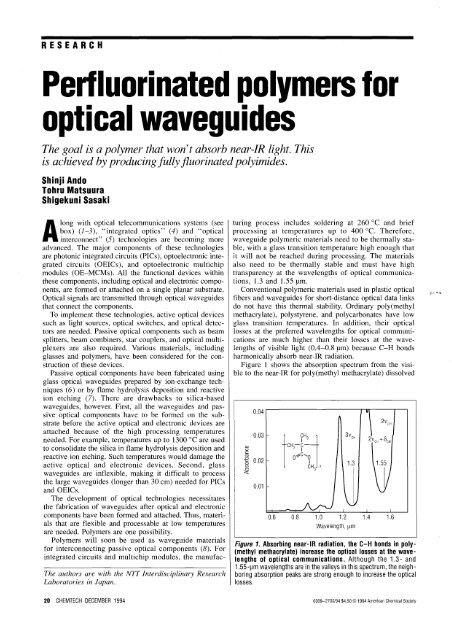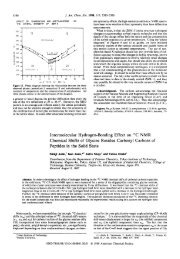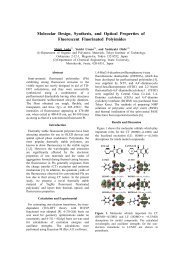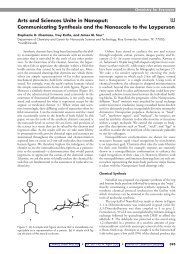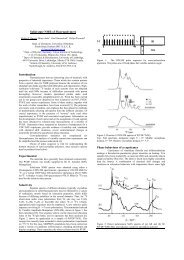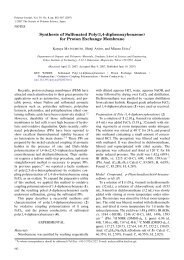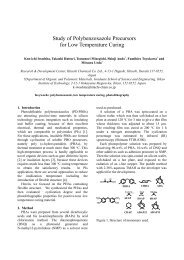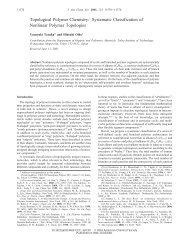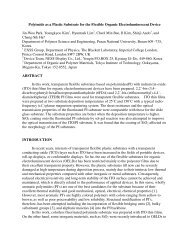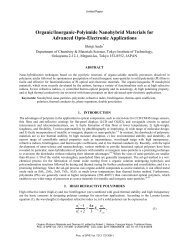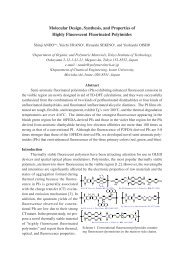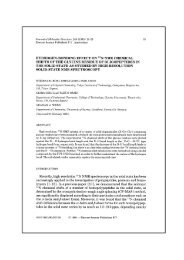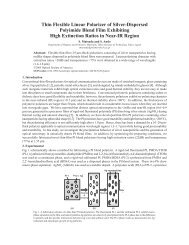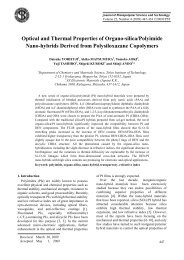Perfluorinated polymers for optical waveguides
Perfluorinated polymers for optical waveguides
Perfluorinated polymers for optical waveguides
You also want an ePaper? Increase the reach of your titles
YUMPU automatically turns print PDFs into web optimized ePapers that Google loves.
RESEARCH<br />
<strong>Perfluorinated</strong> <strong>polymers</strong> <strong>for</strong><br />
<strong>optical</strong> <strong>waveguides</strong><br />
The goal is a polymer that won't absorb near-IR light. This<br />
is achieved by producing fully fluorinated polyimides.<br />
Shinji Ando<br />
Tohru Matsuura<br />
Shigekuni Sasaki<br />
A<br />
long with <strong>optical</strong> telecommunications systems (see<br />
box) (1-3), "integrated optics" (4) and "<strong>optical</strong><br />
interconnect" (5) technologies are becoming more<br />
advanced. The major components of these technologies<br />
are photonic integrated circuits (PICs), optoelectronic integrated<br />
circuits (OEICs), and optoelectronic multichip<br />
modules (OE-MCMs). All the functional devices within<br />
these components, including <strong>optical</strong> and electronic components,<br />
are <strong>for</strong>med or attached on a single planar substrate.<br />
Optical signals are transmitted through <strong>optical</strong> <strong>waveguides</strong><br />
that connect the components.<br />
To implement these technologies, active <strong>optical</strong> devices<br />
such as light sources, <strong>optical</strong> switches, and <strong>optical</strong> detectors<br />
are needed. Passive <strong>optical</strong> components such as beam<br />
splitters, beam combiners, star couplers, and <strong>optical</strong> multiplexers<br />
are also required. Various materials, including<br />
glasses and <strong>polymers</strong>, have been considered <strong>for</strong> the construction<br />
of these devices.<br />
Passive <strong>optical</strong> components have been fabricated using<br />
glass <strong>optical</strong> <strong>waveguides</strong> prepared by ion-exchange techniques<br />
(6) or by flame hydrolysis deposition and reactive<br />
ion etching (7). There are drawbacks to silica-based<br />
<strong>waveguides</strong>, however. First, all the <strong>waveguides</strong> and passive<br />
<strong>optical</strong> components have to be <strong>for</strong>med on the substrate<br />
be<strong>for</strong>e the active <strong>optical</strong> and electronic devices are<br />
attached because of the high processing temperatures<br />
needed. For example, temperatures up to 1300 °C are used<br />
to consolidate the silica in flame hydrolysis deposition and<br />
reactive ion etching. Such temperatures would damage the<br />
active <strong>optical</strong> and electronic devices. Second, glass<br />
<strong>waveguides</strong> are inflexible, making it difficult to process<br />
the large <strong>waveguides</strong> (longer than 30 cm) needed <strong>for</strong> PICs<br />
and OEICs.<br />
The development of <strong>optical</strong> technologies necessitates<br />
the fabrication of <strong>waveguides</strong> after <strong>optical</strong> and electronic<br />
components have been <strong>for</strong>med and attached. Thus, materials<br />
that are flexible and processable at low temperatures<br />
are needed. Polymers are one possibility.<br />
Polymers will soon be used as waveguide materials<br />
<strong>for</strong> interconnecting passive <strong>optical</strong> components (8). For<br />
integrated circuits and multichip modules, the manufac-<br />
The authors are with the NIT Interdisciplinary Research<br />
Laboratories in Japan.<br />
turing process includes soldering at 260°C and brief<br />
processing at temperatures up to 400 °C. There<strong>for</strong>e,<br />
waveguide polymeric materials need to be thermally stable,<br />
with a glass transition temperature high enough that<br />
it will not be reached during processing. The materials<br />
also need to be thermally stable and must have high<br />
transparency at the wavelengths of <strong>optical</strong> communications,<br />
1.3 and 1.55 rm.<br />
Conventional polymeric materials used in plastic <strong>optical</strong><br />
fibers and <strong>waveguides</strong> <strong>for</strong> short-distance <strong>optical</strong> data links<br />
do not have this thermal stability. Ordinary poly(methyl<br />
methacrylate), polystyrene, and polycarbonates have low<br />
glass transition temperatures. In addition, their <strong>optical</strong><br />
losses at the preferred wavelengths <strong>for</strong> <strong>optical</strong> communications<br />
are much higher than their losses at the wavelengths<br />
of visible light (0.4-0.8 rm) because C-H bonds<br />
harmonically absorb near-IR radiation.<br />
Figure 1 shows the absorption spectrum from the visible<br />
to the near-IR <strong>for</strong> poly(methyl methacrylate) dissolved<br />
'" '-'<br />
0.04<br />
0.03<br />
t<br />
I<br />
CH-C<br />
~t'q G~<br />
3v CH<br />
c<br />
.0 '"<br />
a 0.02<br />
1.3<br />
Cfl<br />
CH n<br />
.0<br />
3<br />
«<br />
0.01<br />
2VCH<br />
2VCH + °CH<br />
0.6 0.8 1.4 1.6<br />
Wavelength, ftm<br />
Figure 1. Absorbing near-IR radiation, the C-H bonds in poly<br />
(methyl methacrylate) increase the <strong>optical</strong> losses at the wavelengths<br />
of <strong>optical</strong> communications. Although the 1.3 - and<br />
1.55-~m wavelengths are in the valleys in this spectrum, the neighboring<br />
absorption peaks are strong enough to increase the <strong>optical</strong><br />
losses.<br />
20 CHEMTECH DECEMBER 1994<br />
0009-2703/94 $4.50 © 1994 American Chemical SOCiety
Telephone lines are carrying far more in<strong>for</strong>mation than they<br />
once did because of the increase in online computer communications<br />
and fax transmissions. Because <strong>optical</strong> fibers<br />
can carry so much more in<strong>for</strong>mation, they are replacing the<br />
copper in telephone wires. Instead of electricity, light in the<br />
near-IR part of the spectrum is transmitted through silicabased,<br />
single- mode <strong>optical</strong> fibers.<br />
For <strong>optical</strong> telecommunication systems, a wavelength of<br />
1.3 11m is best <strong>for</strong> the quality of transmission, allowing the<br />
least dispersion. The refractive index dispersion is zero at<br />
1.3 11m, and this wavelength is called the "zero-dispersion"<br />
wavelength <strong>for</strong> these fibers.<br />
However, this <strong>optical</strong> fiber has its minimum transmission<br />
loss at 1.55 11m. To transmit the signal at the highest speed<br />
with the least loss, the zero-dispersion wavelength and the<br />
minimum-loss wavelength should be identical.<br />
Techniques have been developed to shift the zero-dispersion<br />
wavelength of silica -based <strong>optical</strong> fibers to 1.55 11m (1).<br />
To confine the <strong>optical</strong> signal, the refractive index of the core<br />
of the fiber is made slightly higher than that of the cladding.<br />
A small amount of Ge0 2 is doped into the core of the silicabased<br />
fiber. Because this doping does not help to decrease<br />
the transmission loss, fluorine is doped into the cladding.<br />
The fluorine decreases the refractive index of the medium<br />
and inhibits water absorption.<br />
The transmission loss spectrum of such a dispersionshifted<br />
fiber shows that the lowest loss, 0.154 dB/km,<br />
occurs at 1.55 11m (2). This minimum loss is close to the<br />
theoretical limit determined from Rayleigh scattering and the<br />
harmonic absorption of oxygen-hydrogen (O-H) and silicon-oxygen<br />
(Si-O) bond stretching (3).<br />
The sharp absorption peak at 1.38 11m is due to the vibration<br />
of the residual Si-OH groups by the second harmonic of<br />
O-H bond stretching. The <strong>optical</strong> communication wavelengths<br />
of 1.3 and 1.55 11m are located in the valleys between<br />
the absorption peaks, indicating the low transmission losses<br />
Optical telecommunications<br />
at these wavelengths. As a result of the research developments<br />
with silica-based <strong>optical</strong> fibers, the transmission<br />
wavelength will soon be shifted from 1.3 to 1.55 11m in the<br />
<strong>optical</strong> telecommunication systems in Japan.<br />
E<br />
""" co<br />
1.0<br />
-0 0.5<br />
and 6FDA and PMDA as the dianhydrides.<br />
o 0<br />
II<br />
II<br />
o~C~C~O<br />
c~c<br />
II<br />
II<br />
o 0<br />
Increasing the PMDA ratio made the refractive index of<br />
the core slightly higher than that of the cladding.<br />
In the fabrication process, an undercladding layer and a<br />
core layer of the polyimide are <strong>for</strong>med on a substrate (Figure<br />
3). The undercladding is <strong>for</strong>med by spin coating of the<br />
substrate with poly(amic acid) solution (a prepolymer<br />
solution of the anhydride and the diamine) followed by<br />
thermal imidization. The difference in refractive index<br />
between the core and the undercladding is about 0.4%.<br />
The core ridge is then fabricated by photolithographic patterning<br />
and reactive ion etching with the use of oxygen.<br />
Finally, an overcladding layer is <strong>for</strong>med.<br />
These fluorinated polyimide <strong>waveguides</strong> have <strong>optical</strong><br />
losses of
OJ<br />
'-'<br />
c:<br />
eO<br />
-2<br />
o<br />
.c '"<br />
Table 1. Molecular structure and properties of amorphous and semicrystalline perfluoro<strong>polymers</strong><br />
(/X(I" (Cf~f,+.-<br />
F F F F<br />
~rf+ --{Cf,-Cf+<br />
Property<br />
F3C CF3 F F<br />
TellonAF<br />
Morphology<br />
Amorphous<br />
Fluorine content, wt % 67.1,65.0<br />
Glass transition temp., °c<br />
160, 240 a<br />
Melting point, °c<br />
Dielectric constant 1.89-1.93<br />
Refractive index 1.29-1.31<br />
Optical transmittance, % >95<br />
(visible region)<br />
a The glass transition temperature with no TFE content is higher than 300°C.<br />
Cytop<br />
PTFE<br />
Amorphous<br />
Semicrystalline<br />
67.9 76.0<br />
108<br />
327<br />
2.1-2.2 2.1<br />
1.35 1.38<br />
95 Opaque<br />
We first determined the reactivIties of the diamines<br />
shown in Figure 6 by synthesizing poly(amic acid)s using<br />
6FDA as the dianhydride. Note that 6FDA is not perfluorinated.<br />
The end-group contents of the poly(amic acid)s that<br />
were determined from 19F NMR are as follows:<br />
• 4FMPD tetrafluoro-m-phenylenediamine 15%<br />
• 4FPPD tetrafluoro-p-phenylenediamine 42%<br />
• 8PODA<br />
bis(2,3,5,6~tetrafluoro-4-<br />
75%<br />
aminopheny 1 )ether<br />
• 8FSDA bis(2,3,5,6-tetrafluoro-4-<br />
91%<br />
aminophenyl)sulfide<br />
• 8FBZ 4,4'-diaminooctofluorobiphenyl >99%<br />
Of these, 4FMPD shows the lowest end-group content, or<br />
the highest reactivity, and 4FPPD shows the next lowest<br />
end-group content.<br />
However, <strong>for</strong> all the diamines, the acylations were not<br />
complete, and end-group contents were still high even<br />
after 6 days of reaction at room temperature. When 8FBZ<br />
diamine, the least reactive one, was reacted with 6FDA, no<br />
NMR signal <strong>for</strong> the poly(amic acid) was detected. The<br />
electron-donating properties of the diamines, which determine<br />
the reactivity of diamines <strong>for</strong> acylation, matched the<br />
end-group contents of the poly(amic acid)s (20). We estimated<br />
the electron-donating properties from 15N NMR<br />
chemical shifts and from electron-related parameters such<br />
as ionization potential, electronic affinity, and molecular<br />
orbital energy.<br />
However, Hougham and co-workers at IBM have prepared<br />
continuous films using 6FDA as the dianhydride and<br />
4FPPD and 8FBZ as diamines (22). They showed that two<br />
Figure 6. These structures are used to<br />
synthesize perfluorinated polyimides.<br />
This perfluorinated dianhydride and the five<br />
perfluorinated diamines may be purchased<br />
or prepared by known procedures.<br />
F<br />
F F<br />
F<br />
4FPPD<br />
4FMPD<br />
F<br />
F F<br />
BFBZ<br />
F<br />
""*S*'"' ""*0*'",<br />
F F F F F F F F<br />
BFSDA<br />
BFODA<br />
24 CHEMTECH DECEMBER 1994
~ .... ',I;<br />
stages of polymerization are needed to obtain high molecular<br />
weight polyimides from the perfluorinated diamines:<br />
a solution polycondensation at temperatures of 130 °c_<br />
150°C followed by a high-temperature, solid state chain<br />
extension.<br />
A novel perfluorinated dianhydride is needed<br />
The introduction of fluorine or fluorinated groups into<br />
dianhydrides increases their reactivity. The 13C NMR<br />
chemical shift of carbonyl carbons (oC) of P6FDA suggests<br />
a considerable increase in reactivity (20). There<strong>for</strong>e,<br />
P6FDA should compensate <strong>for</strong> the low reactivity of perfluorinated<br />
diamines.<br />
However, the end-group content of the poly(amic acid)<br />
synthesized from 4FMPD and P6FDA was 36% (just<br />
higher than that from 4FMPD and 6FDA). Furthermore,<br />
the resultant perfluorinated polyimide P6FDA--4FMPD<br />
/ R*CF3 C 0 ~ \ N<br />
N /<br />
\ C<br />
C II F<br />
g CF3 0<br />
was cracked and brittle and did not <strong>for</strong>m a continuous<br />
film. For the other four diamines, the polyimides prepared<br />
with P6FDA were coarse powders or films that had many<br />
cracks.<br />
The main reason the films are not continuous is that the<br />
high reactivity of the perfluorinated dianhydride probably<br />
could not compensate <strong>for</strong> the low reactivities of perfluorinated<br />
diamines. However, the rigidity of the polymer<br />
chain cannot be neglected in the cases of P6FDA and onebenzene-ring<br />
diamines. In this situation, bond rotation is<br />
permitted only at the imide linkage (nitrogen aromatic<br />
carbon bond). However, this rotation is restricted by steric<br />
hindrance between the fluorine atoms and carbonyl oxygens.<br />
The rigidity of the polymer chain must be improved<br />
by the introduction of flexible linkage groups into the<br />
dianhydride component. Accordingly, we would expect to<br />
make continuous and flexible films of perfluorinated polyimides<br />
by combining diamines, which have high reactivities,<br />
with dianhydrides, which have flexible molecular<br />
structures.<br />
We synthesized a novel perfluorinated dianhydride, 1,4-<br />
bis (3 ,4-dicarboxytrifl uorophenox y )tetrafluoro benzene<br />
dianhydride (lOFEDA), as in the first three steps of the<br />
scheme in Figure 7. This molecule has two ether linkages<br />
that give flexibility to the molecular structure. In addition,<br />
the chemical shift of carbonyl carbons of lOFEDA was<br />
almost the same as that of P6FDA. There<strong>for</strong>e, this dianhydride<br />
should have a reactivity that is higher than those of<br />
unfluorinated and partially fluorinated dianhydrides.<br />
The end-group content of the poly(amic acid) prepared<br />
from lOFEDA and 4FMPD was 6%, which is much less<br />
than that of poly(amic acid) prepared from P6FDA and<br />
4FMPD (36%). This result can be attributed to the considerable<br />
increase in flexibility of the dianhydride structure.<br />
The resultant perfluorinated polyimide (lOFEDA-<br />
4FMPD) was a 9.5-).lm-thick, strong, flexible film that had<br />
a pale yellow color like DuPont's Kapton. The structure of<br />
the lOFEDA--4FMPD polyimide was confirmed by elemental<br />
analysis, IR spectroscopy, and 19F NMR (23).<br />
Figure 8 (p. 26) shows the visible-to-near-IR absorption<br />
F<br />
F<br />
F<br />
spectrum of lOFEDA--4FMPD, cured at 200°C and dissolved<br />
in acetone-d 6 (10 wt %). The same amount of acetone-d<br />
6 was used as a reference. The solid line indicates<br />
the absorbance of lOFEDA--4FMPD, and the dashed line<br />
indicates the absorbance of partially fluorinated polyimide<br />
(6FDA-TFDB).<br />
to F3C CF3 0<br />
II \ ! II<br />
N:)~)Cl~I)<br />
II<br />
II<br />
o 0 F3C<br />
F<br />
NC*F<br />
2 0<br />
NC F<br />
F<br />
TFPN<br />
F<br />
F<br />
+ HO*OH<br />
j Et3N<br />
in DMF<br />
F<br />
TFHQ<br />
NC*' o*o*F CN<br />
NC F F F F CN<br />
10FEDP<br />
! H2S04 aq.<br />
HOOC*' o*o*F COOH<br />
HOOC F F F F COOH<br />
F l~ F<br />
)*'<br />
FF<br />
o*o*F g,o<br />
,OF F 0 /<br />
R F F R<br />
o F 10FEOA F 0<br />
F<br />
N<br />
NH<br />
in DMAc + H2 * 2<br />
11* *111*1<br />
F<br />
F F<br />
OF * F OH F H<br />
COO 0 C-N N<br />
HOOC 0 F F F F 0 COOH F 0 F<br />
F 1 ~ F F<br />
)*'<br />
F F<br />
O*O*F g'N<br />
'c 0 F F 0 c'<br />
II F F II F<br />
OFF 0<br />
10FEOA/4FMPO<br />
Figure 7. This scheme shows the steps <strong>for</strong> synthesizing a new<br />
perfluorinated dianhydride, 10FEDA. From this anhydride, a poly<br />
(amic acid) is prepared from which the perfluorinated polyimide is<br />
derived.<br />
F<br />
F<br />
F<br />
CHEMTECH DECEMBER 1994 25
'" '-'<br />
c<br />
..c<br />
'"<br />
0<br />
(J)<br />
..c<br />
-0::<br />
0.04<br />
0.03<br />
0.01<br />
-10FEDN4FMPD<br />
$ 1 \<br />
2VCH~:~;<br />
6F::::~ 1 \<br />
2V$CH + O$CH<br />
3v$ -[ ~<br />
CH j\ ... ................................. .<br />
Table 2. Strengths and flexibilities of perfluorinated<br />
polyimide films<br />
Dianhydride<br />
Diamine 1DFEDA P6FDA<br />
4FPPD<br />
No film<br />
4FMPD Strong and flexible Brittle and cracked<br />
8FODA Flexible Nofilm<br />
8FSDA Flexible Nofilm<br />
8FBZ Nofilm Nofilm<br />
0.6 0.8 1.0 1.2 1.4 1.6<br />
Wavelength, 11m<br />
Figure 8. The perfluorinated polyimide 10FEDA-4FMPD does not<br />
have a substantial absorption peak over the wavelengths <strong>for</strong> <strong>optical</strong><br />
communication. However, the partially fluorinated polyimide<br />
6FDA-TFDB does have one. For 10FEDA-4FMPD, indicated by the<br />
solid line over the shaded area, the small peak at 1.4 ~m is caused<br />
by moisture, and the line below it shows what the absorbance<br />
would be without the moisture.<br />
Except <strong>for</strong> a small absorption peak at l.4).lm caused by<br />
moisture absorbed in the solvent or adsorbed onto the polyimide<br />
film, the perfluorinated polyimide has no substantial<br />
absorption peak over the wavelengths <strong>for</strong> <strong>optical</strong> communication.<br />
However, partially fluorinated polyimide has an<br />
absorption peak that arises from the third harmonic of the<br />
stretching vibration of the C-H bond (1.1 ).lm), a peak that<br />
results from the combination of the second harmonic of<br />
stretching vibration and the de<strong>for</strong>mation vibration of the<br />
C-H bond (1.4 ).lm), and a peak that is attributable to the<br />
second harmonic of the stretching vibration of the C-H<br />
bond (1.65 ).lm). In the visible spectrum, the electronic<br />
transition absorption of lOFEDA-4FMPD is slightly<br />
shifted to longer wavelengths than that of 6FDA-TFDB.<br />
This shift causes the yellowish color of lOFEDA-4FMPD<br />
but does not affect the transparency at near-IR wavelengths.<br />
Table 2 lists the strengths and flexibilities of perfluorinated<br />
polyimide films synthesized from the two dianhydrides<br />
and five diamines. Polymerizing lOFEDA with<br />
8FODA or 8FSDA produced continuous, flexible films,<br />
but the films are slightly brittle compared with lOFEDA-<br />
4FMPD. As already mentioned, P6FDA did not give any<br />
continuous films.<br />
The properties of perfluorinated polyimides, along with<br />
those of partially fluorinated and unfluorinated polyimides,<br />
are listed in Table 3. The structure of PMDA-ODA<br />
is the same as that of Kapton. Because the lOFEDA component<br />
has a flexible structure, the polymer decomposition<br />
temperatures and glass transition temperatures (Tgs) of<br />
perfluorinated polyimides are slightly lower than those of<br />
conventional polyimides. Nonetheless, the thermal stability<br />
of these films is considered high enough to be able to<br />
withstand the manufacture of integrated circuits and multichip<br />
modules.<br />
In addition, the direct introduction of fluorines into the<br />
aromatic rings does not cause a substantial increase in fluorine<br />
content. The adhesiveness of the perfluoropolyimides<br />
is thus equivalent to that of the partially fluorinated<br />
polyimides used to fabricate single-mode <strong>waveguides</strong>.<br />
Their dielectric constants (E) at 1 kHz and their average<br />
refractive indices are as low as those of the partially fluorinated<br />
polyimides. The reason <strong>for</strong> these similarities is that<br />
the fluorine content of perfluorinated polyimides is comparable<br />
to that of partially fluorinated polyimides.<br />
However, the birefringence of perfluorinated polyimides<br />
is lower than that of partially fluorinated polyimides. This<br />
difference is caused by the steric effect between perfluorinated<br />
aromatic rings and bent structures such as ether,<br />
thio-ether, and meta linkages. The low birefringence is<br />
convenient <strong>for</strong> designing waveguide structures in the interconnections<br />
of OEICs and multichip modules.<br />
The refractive indices of perfluorinated polyimides can<br />
be controlled by copolymerization in the same manner as<br />
those of partially fluorinated polyimides (14). These characteristics<br />
show that perfluorinated polyimides are promising<br />
materials <strong>for</strong> <strong>waveguides</strong> in integrated optics and<br />
<strong>optical</strong> interconnect technology.<br />
Table 3. Properties of perfluorinated polyimides, partially fluorinated polyimides, and unfluorinated polyimides<br />
Average<br />
Fluorine Decomposition Dielectric refractive Bir!!fringence,<br />
content, % temp.,oC Tg,oC constant, E index, Ii nTE-n TM<br />
10FEDA-4FMPD 36.6 501 309 2.8 1.562 0.004<br />
10FEDA-8FODA 38.4 485 300 2.6 1.552 0.004<br />
10FEDA-8FSDA 37.7 488 278 2.6 1.560 0.006<br />
10FEDA-TFDB 35.1 543 312 2.8 1.569 0.009<br />
6FDA-TFDB 31.3 553 327 2.8 1.548 0.006<br />
PMDA-TFDB 22.7 613 >400 3.2 1.608 0.136<br />
PMDA-ODA 0 608 >400 3.5 1.714 0.088<br />
26 CHEMTECH DECEMBER 1994
References<br />
(1) Cohen, L G,; Lin, c'; French, W G, Electron. Lett. 1979, 15, 334.<br />
(2) Yokota, H.; Kanamori, H.; Ishiguro, Y.; Shinba, H. Technical Digest<br />
of the Optical Fibers Conference' 86, Atlanta; Conference on Optical<br />
Fiber Communication, Washington, DC, 1986, post-deadline<br />
Paper 3.<br />
(3) Miya, T.; Terunuma, Y.; Hosaka, T.; Miyashita, T. Electron. Lett.<br />
1979, 15, 106.<br />
(4) Miller, S. E. Bell. Syst. Tech. J. 1969,48, 2059.<br />
(5) Goodman, J. W.; Leonberger, F. J.; Kung, S.; Athale, R Proc. IEEE<br />
1984, 72, 850.<br />
(6) Seki, M.; Sugawara, R.; Hashizume, H.; Okuda, E. Proceedings of<br />
the Optical Fibers Conference' 89, Houston, Conference on Optical<br />
Fiber Communication, Washington, DC, 1989, post-deadline Paper<br />
4.<br />
(7) Kawachi, M.; Kobayashi, M.; Miyashita, T. Proceedings of the<br />
European Conference on Optical Fiber Communication '87, Helsinki;<br />
The Consulting Committee of the Professional Electroengineers<br />
Organization, Helsinki, Finland, 1987, p. 53.<br />
(8) Kurokawa, T.; Takato, N.; Katayama, T. Appl. Opt. 1980,19,3124.<br />
(9) Furuya, K.; Miller, B. I.; Coldman, L A.; Howard, R. E. Electron.<br />
Lett. 1982, 18, 204.<br />
(10) Franke, H; Crow, J. D. "Integrated Optical Circuit Engineering III,"<br />
Kersten, R T., Ed.; Proc. SPIE 1986, 651, 102.<br />
(11) Sullivan, C. T. "Optoelectronic Materials, Devices, Packaging, and<br />
Interconnects II," McWright, G. M.; Wojtunik, H. J., Eds.; Proc.<br />
SPIE 1988, 994, 92.<br />
(12) Hagerhorst-Trewhella, J. M.; Gelome, J. D.; Fan, B.; Speth, A.; Flagello,<br />
D.; Oprysko, M. M. "Integrated Optics and Optoelectronics,"<br />
Wong, K.; Wojtunik, H. J.; Peng, S. T.; Mentzer, M. A.; McCaughan,<br />
L, Eds; Proc. SPIE 1990, 1177, 379.<br />
(13) Reuter, R; Franke, H.; Feger, C. Appl. Opt. 1988, 27, 4565.<br />
(14) Matsuura, T.; Ando, S.; Matsui, S.; Sasaki, S.; Yamamoto, S. Electron.<br />
Lett. 1993,29,2107.<br />
(15) Matsuura, T.; Hasuda, Y.; Nishi, S.; Yamada, N. Macromolecules<br />
1991,24,5001.<br />
(16) Kaino, T.; Fujiki, M.; Nara, S. 1. Appl. Phys. 1981, 52, 7061.<br />
(17) Kaino, T.; Jinguji, K.; Nara, S. Appl. Phys. Lett. 1983,42,567.<br />
(18) Imamura, S.; Yoshimura, R; Izawa, T. Electron. Lett. 1991, 27,<br />
1342.<br />
(19) Aosaki, K. Plastics (Japan) 1991,42,51.<br />
(20) Ando, S.; Matsuura, T.; Sasaki, S. In Polymers <strong>for</strong> Microelectronics,<br />
Resists, and Dielectrics; Thompson, L F.; Willson, C, G.; Tagawa,<br />
S., Eds.; ACS Symposium Series 537; American Chemical Society:<br />
Washington, DC, 1994; p. 304.<br />
(21) Bessonov, M. I.; Koton, M. M.; Kudryavtsev, V. Y.; Laius, L A.<br />
Polyimides, Thermally Stable Polymers; Consultants Bureau: New<br />
York, 1987; Chapter 2.<br />
(22) Hougham, G.; Tesoro, G.; Shaw, J. In Polyimides, Materials, Chemistry,<br />
and Characterization; Feger, c'; Khojasteh, M. M.; McGrath,<br />
J. E., Eds.; Elsevier Science Publishers: Amsterdam, 1989; p. 465.<br />
(23) Ando, S.; Matsuura, T.; Sasaki, S. Submitted <strong>for</strong> publication in<br />
Magn. Reson. Chem.<br />
Tohru Matsuura is a Research Scientist at<br />
NTT Interdisciplinary Research Laboratories,<br />
where he develops high-per<strong>for</strong>mance fluorinated<br />
polyimides <strong>for</strong> <strong>optical</strong> applications and<br />
fabricates <strong>optical</strong> waveguide circuits. He joined<br />
NTT Electrical Communications Laboratories in<br />
1986 and received his Ph.D. in Organic and<br />
Polymeric Materials from Tokyo Institute of<br />
Technology in 1993.<br />
Shinji Ando is a Research Scientist at Nippon<br />
Telegraph and Telephone Corporation (NTT<br />
Interdisciplinary Research Laboratories, Midoricho<br />
3-9-11, Musashino-shi, Toyko, 180 Japan;<br />
+81-422-59-3042, e-mail anshin@aela.ntt.jp).<br />
His research interests include the <strong>optical</strong> properties<br />
and electronic structure of fluorinated polyimides<br />
and <strong>optical</strong> components made from these<br />
materials. He received his Ph.D. in Polymer<br />
Chemistry at Tokyo Institute of Technology in<br />
1989 and has been with NTT ever since.<br />
Shigekuni Sasaki is Head of the Advanced<br />
Organic Materials Research group at NTT Interdisciplinary<br />
Research Laboratories. His group<br />
research focuses on the development of <strong>optical</strong><br />
fluorinated polyimides and their application to<br />
<strong>optical</strong> communication components. He joined<br />
NTT Electrical Communications Laboratories in<br />
1977 and received his Ph.D. in Applied Chemistry<br />
from Tokyo Institute of Technology in<br />
1991.<br />
EDUCATION: AN INDUSTRIAL IMPERATIVE<br />
Our educational system does not appear to be capable<br />
of producing persons with the flexibility necessary to<br />
deal with the changes that American industry feels are<br />
imperative if it is to be competitive. Neither does our<br />
educational system seem to be capable of undergoing<br />
the changes necessitated by today's societal pressures.<br />
Conventional wisdom currently holds that future<br />
workers should be able to acquire the flexibility necessary<br />
to respond to changing needs by learning new<br />
skills in an appropriate educational system. It's not as<br />
if the American educational system is lacking resources;<br />
rather, it appears that the system does not provide<br />
those elements of education that infuse students with<br />
the ability to learn new skills.<br />
J. J. Lagowski<br />
Editor, Journal of Chemical Education<br />
CHEMTECH DECEMBER 1994 27


